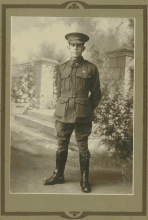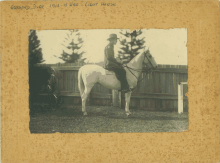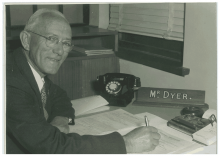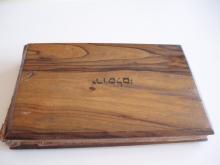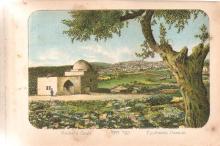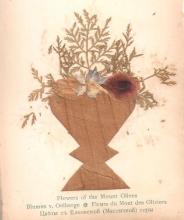Martin Luther Dyer
Martin Luther Dyer's photos and memoir have been shared with Wollongong City Libraries by his relatives. The memoir was written following his retirement and contains a great deal of information regarding his service at the front as well as details of his life.
Below is the memoir; in order to stay true to its original meaning, it has not been changed when typed up.*
Life Story of Martin Luther Dyer
Born at Cables Siding (Penrose)
On the 30th August, 1893.At the age of four my parents moved to Woonona, after a short stay moved to Bulli and Wollongong, for a period of approx. 28 [?] months. Thence leaving for Blayney, where I commenced school at the age of six. In 1901 we moved to Lithgow for a short period again returning to Woonona, where my father died at the age of 50. I left Woonona Public School at the age of 13 years and 9 months. With my mother, sister and two brothers again moved to Lithgow where I commenced my first employment in a store at a weekly wage of 2/6.
After twelve months, I transferred to […] Store. Nathan Basser, who shortly after secured the contract for the supply of foodstuff to the 400 navvies, constructing the ten tunnels to replace the Great Western Zig-Zag for the Department of Railways. I was given the job to collect and deliver all goods over a period of 3 years. This entailed riding on horseback & driving through rugged mountain country in all weather. I had two attempts on my life while carrying money from the camps, but came through without injury. One occasion, a stout rope had been tied to two trees across a mountain track. I was riding a powerful horse through driving snow, the horse saw the rope and threw his head down suddenly, pulling me on to his neck, the rope scraped along my back but otherwise it was my lucky break, saved by my horse.
Shortly after the outbreak of World War I, I moved once again to Wollongong where I set up in business. In 1916 I arranged for a brother to take over, and I enlisted in the War in the 7th Australian Light Horse. After a short period of training we embarked on the [HMAT]Boorara en-route for Egypt. Owing to a submarine scared put into Port Melbourne for a few weeks. It was a nightmare voyage. The Captain stated it was the roughest trio he had ever made, mountainous seas and no lights at night and everyone on the alert. Before reaching Egypt an epidemic of mumps broke out, and I was one of the unfortunate ones. In my case it took a serious turn and I was taken off by stretcher and placed in the Egyptian Gov’t hospital at Port Tewfik, with little hope of survival. However, I pulled through and was sent to the Moasca[sic] training camp in the desert.
Shortly after, we moved to the combat area to make our acquaintance with the enemy. This resulted in desert skirmished over vast areas as the enemy were attacking from different positions. However, we had them on the run and advancement so rapid that Headquarters found it difficult to keep supplies and ammunition up to our troops. The Egyptian Labour Corps were laying a mile of railway a night. No work could be done during the day due to enemy action. All those of course was over desert with large sand dunes, hence the time taken. The Gypos [sic] were like ants but the progress was slow.
Eventually the Authorities decided to form a train of mule and horse transport to speed up supplies. They selected a number of expert horsemen to return to Moasca[sic] where wagons, mules and horses were awaiting. I was one of the Company. We had to break in the mules to drive four in hand, which was a tedious and sometimes dangerous experience. A mule can be stubborn and can kick your hat off standing at his head. We accomplished the job in record time and set off across the desert to pick up the regiment. A lot of the time had to be done at night for fear of air raids. Pulling through the deep sand taxed the animals but they stood the test well. We first made contact with our Companies near the Sinai Peninsula.
Our Unit was named the Anzac Mounted Divisional Train. We were now leaving the desert behind and coming to the fertile part of Palestine. Our first encounter with the front line was near Beersheba where some fierce fighting was taking place. We had to drive at night without lights, which was most hazardous, enemy dead were laying everywhere. Next village encountered was Gaza and from there on we entered the fertile country. Orange groves, vineyards and olive grove were plentiful. After existing on very little but tin ‘Bully beef’ and biscuits for months, a change of fruit and some vegetables plus an issue of wine worked wonders with the health of the troops. Village after village fell to our troops in quick succession – Richon Le Zion, Jaffa, Ludd (or Lydda). Here we had a respite for some weeks as the enemy were entrenched in the hills ahead.
Finally, we started the ascent towards Bethlehem and Jerusalem. Here we encountered heavy rain and cold weather. It snows in the mountains at Winter. Being unprepared coming off the desert, colds and pneumonia were prevalent. We took every opportunity to see as much as possible of the Ancient Biblical Scenes – in Bethlehem where Christ was born – Jerusalem was most interesting. The old city is walled with massive stoneworks, some 20 feet high. In it we visited the Church of the Holy Sepulchre in the basement of which is part of the original Pilate’s Judgement Hall. The Jews’ Wailing Wall – this Wall was erected by Moslims [sic] to prevent the Jews visiting their Ancient Shrine of Worship. The church many years ago was demolished and The Mosque of Omar erected. This Mosque contains some of the most priceless Mosaic, Alabaster Columns and jewels. Outside the city is the Garden of Gethsemane. A Russian Orthodox Church is a thing of exquisite beauty – five domes are sheeted with gold, and can be seen from miles distant.
We now began the long downward trek to the Jordan Valley. The road is very steep and extends for many miles. The Valley itself is a barren track of country, chalky dust a foot deep and little if any vegetation. It is 1300 feet below sea levels and claimed to be one of the hottest places in the world. The average summer temperature is 132% [sic] in the shade, that is if you can find any. The Dead Sea extends for miles and there is no tide. Although fed by the fresh river Jordan, it never gets any less salty. No fish can live in it, hence the name. In the face of the rocky mountainside there is an ancient monastery occupied by monks. The few Bedouin tribes that live there move up to the hills in summer on account of the intense heat.
We were kept there for some months until a pontoon bridge was constructed over the Jordan and the fact that a large concentration of troops were massed in the hills ahead. When the all-out advance was ready to proceed, the horses got over safely, but the English officers said the heavy wagons with four mules or horses would have to be led over. Our officers disagrees, and I was approached to know If I was game to make the attempt. The bridge was constructed of planks tied to casks with rope. I offered to give it a try, and drove down a steep bank onto the bridge. The animals panicked for a while but I managed to get across. We made the crossing on several occasions and took supplies to Es-sauer, Amman and Damascus. We were bombed and shelled occasionally, but only on one occasion did we suffer serious loss. We were bombed one early morning and lost a few men and animals.
Tragedy struck in another form. Dysentery and malaria broke out, and took a heavy toll. I became a victim and was taken by ambulance to a hospital at Jerusalem and the by hospital train back to the 14th Australian General Hospital at Port Said, where I was a patient for 3 months. Leaving hospital I was sent back to Moasca[sic], prior to going back to the front line. Meanwhile, word arrived from Cairo and the principal City of Egypt for someone with clerical and story ability to go and make an inventory of surgical supplies and equipment. I was selected and arrived at Cairo and completed the job. Just prior to finishing, the War ended, so for a few weeks I had the opportunity to visit some of the principal places of historic interest the great Pyramids, Sphinx, Ali Mohommed Mosque, one of the most beautiful in the world, also many others. Leaving Cairo I returned again to Moasca [sic] to await embarkation for home.
In early February 1919, the long awaited word arrived and we proceeded by Lighter to board the City of Exeter. We had a good trip home, called at Colombo for a day and inspected some tea plantations in Ceylon and other interesting sites, arrived in Sydney 19th March and realised there is no place like home.
I received a Royal welcome home. On arrival at Wollongong, the VADs formed a guard of honour and the Band preceded another soldier and myself to the Town Hall where speeches of welcome were made by the Mayor and others.
I went back to business after a brief holiday and on the 13th September 1919, was married at Lithgow by Rev. RC Oakley. On the 3rd July 1920, our first child was born, Winifred Lily and soon gave up the business and moved to Nowra as a representative of a Sydney Firm. On the 9th of May 1922, our second child was born, William Morris. After some months we returned to Wollongong where I entered business until 1924 when I took a position with the Wollongong City Council as a Traffic Inspector and Ranger.
I carried out point duty for 3 or 4 years each weekend at Keira and Crown St. I became absorbed in various additional positions as years went by, Clerical Assistant, Health Inspector, Building Inspector etc. On the 25th October 1929, James Henry was born. I finally retired on 29th August 1959 after 35 years with the Council. I received a beautiful presentation and a testimonial dinner on retiring.
I was a foundation member of Wiseman Park Bowling Club and have been in Office for 12 years in nearly every position up to President.
According to the Illawarra Mercury, Martin owned a grocery business on Crown St Wollongong. The article also states that he was the sole supporter of his widowed mother and sister and that he had two brothers, one being in Queensland and the other was his business partner.
Martin Luther Dyer died in April 1971.
